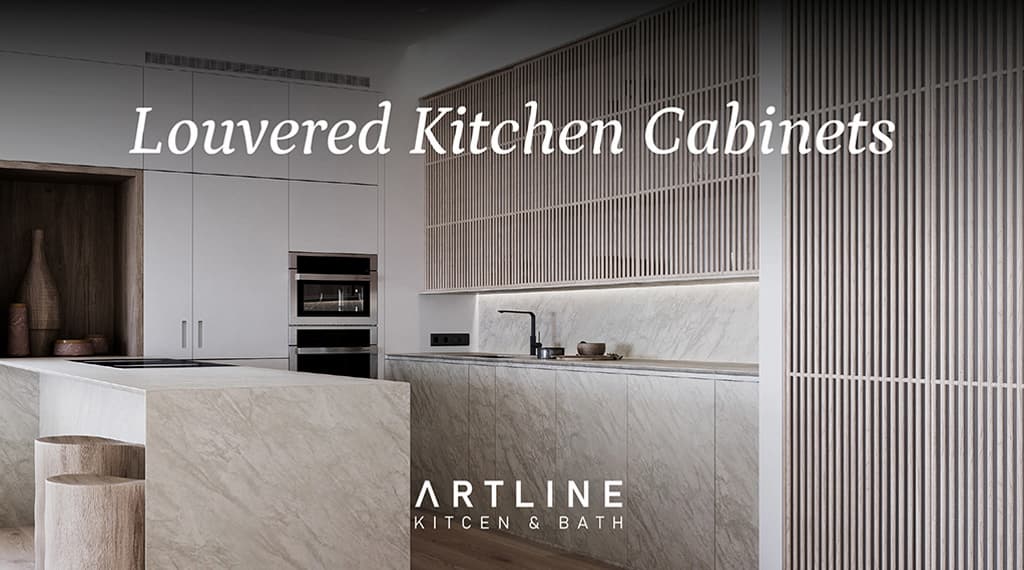Louvered kitchen cabinets combine function and design, offering built-in ventilation through horizontal slats while adding visual texture and charm. They’re especially well-suited for kitchens where airflow is a concern, such as pantries, appliance garages, or utility areas, and they bring coastal, tropical, or traditional style to life when used in the right finish.
Common materials include MDF, plywood, solid wood, and PVC, each with its own balance of cost and durability. Painted finishes, such as white, cream, or navy, give a clean or bold look, while natural wood stains, like teak and walnut, enhance warmth. Whether used for complete cabinet runs or as accent doors on an island or tall pantry, louvered cabinets introduce depth and dimension into kitchen layouts.
They require a bit more maintenance than flat or shaker styles, particularly around the slats, but regular cleaning keeps them fresh. While custom louvered cabinetry can be costly due to labor and craftsmanship, faux slatted options and strategic placement make them a budget-friendly alternative.
Design-wise, they pair well with beach house kitchens, vintage cottages, and island-inspired spaces. However, with the right color and hardware, they can also soften the modern or transitional look of a room. Compared to shaker cabinets, louvered doors offer more airflow and texture, while shaker remains more versatile and low-maintenance.
Louvered cabinets are a smart choice when you want both style and practical ventilation, especially in kitchens with character, as they provide light and airflow.
Table of Contents
ToggleWhat Are Louvered Cabinets?
Louvered cabinets (slatted or shutter-style cabinets) feature doors with horizontal wooden slats spaced evenly apart. These slats are typically fixed in place, creating narrow openings that allow for ventilation while maintaining privacy and structural integrity. This design adds texture and a distinct architectural detail to kitchens.
Unlike flat-panel or shaker cabinets, louvered cabinets allow air to pass through, making them ideal for pantry cabinets, utility closets, or laundry spaces. The gaps help prevent moisture buildup, especially in humid or coastal environments.
Louvered designs originated in plantation-style and coastal homes, where natural ventilation was a necessity. Today, they remain popular in beach-inspired, tropical, and traditional kitchens for their functional and relaxed visual appeal.
Why Choose Louvered Cabinets in a Kitchen?
Louvered cabinets serve practical purposes, making them a smart choice for specific areas of the kitchen. Their slatted design offers natural airflow and adds character to spaces that might otherwise feel flat.
- Built-in ventilation: The horizontal slats allow air to move freely, which helps prevent moisture buildup in pantries, under-sink cabinets, and utility zones.
- Unique look that adds dimension: Louvered doors introduce shadow lines and texture, breaking up large cabinet walls with visual interest.
- Works well in coastal, tropical, and traditional homes: The design aligns perfectly with open, breezy interiors, adding an authentic touch to regional or heritage-inspired spaces.
- Brings airflow to enclosed spaces: Enclosed cabinet areas that house small appliances, cleaning supplies, or wine collections benefit from natural ventilation without the need for additional hardware or fans.
This balance of function and style makes louvered cabinets a strong choice for both practical renovations and design-driven kitchens.
What are the Types of Louvered Cabinet Doors?
Fixed louvered doors, operable louvered doors, and faux louvered doors are the three main types of louvered cabinet doors, distinguished by the construction of their slats and their functional purpose. While all versions share the same horizontal slat look, the way they’re built can affect airflow, maintenance, and design flexibility.
Fixed Horizontal Louvers
Fixed louvered doors are the most common style. The wooden slats are angled and permanently set into the frame, allowing passive airflow between the cabinet interior and the room.
This type is ideal for pantry doors, trash cabinet enclosures, or under-sink storage where ventilation is essential. It’s used purely for design, adding texture and movement to otherwise solid cabinetry. Fixed louvers are low maintenance, secure, and give off a casual, coastal feel.
Operable or Functional Louvers
Operable louvers offer adjustable airflow. The slats tilt open or closed using a control bar or lever, similar to those found on window shutters.
This type is typically found in custom cabinetry, especially for wine storage, appliance garages, or dual-purpose storage areas. It’s functional but more expensive due to added mechanics.
Decorative Faux Louvers
Faux louvered doors give the appearance of a slatted design without open gaps. The “slats” are routed or molded into a solid surface for visual effect only.
This version works well when you want the louvered look but don’t need ventilation. It’s often used in kitchens where a consistent design is essential but airflow isn’t required, such as upper cabinets or built-ins that sit next to real louvered units. Faux louvers are easier to clean and less likely to trap dust.
Each style serves a different purpose, from enhancing practical airflow to promoting design cohesion. Choosing the right type depends on where it’s going and how much ventilation or texture you want.
Best Materials for Louvered Cabinets
The material you choose for louvered cabinets affects not only the cabinet’s appearance but also its durability, weight, and long-term maintenance requirements. Since louvered doors involve individual slats or routed patterns, the base material must be stable and precise.
Solid wood
- Durable and long-lasting
- Can be stained or painted
- Offers a premium, traditional finish
- Slightly heavier and more expensive
- Best for custom or high-end louvered doors
Plywood
- Lighter than solid wood, yet structurally stable
- Resists warping better than MDF
- Works well with veneered finishes
- May require edge banding for a polished look
- Suitable for semi-custom cabinetry with louvers
MDF with Routed Louvers
- Cost-effective and widely available
- Smooth surface that’s ideal for paint
- Not suitable for humid areas unless sealed
- Offers the louvered look without individual slats
- Great for faux louver designs or decorative panels
PVC or Engineered Wood
- Moisture-resistant and low maintenance
- Common in bathrooms or utility spaces
- Limited texture and color options
- Not ideal for stain finishes
- Good for functional louvers in high-humidity zones
Choosing the right material depends on the room’s conditions, your design goals, and your budget. For kitchens with varying humidity, plywood or sealed MDF can be a smart middle ground. For high-end or stain-grade finishes, solid wood offers the best appearance and longevity.
Popular Finishes and Colors for Louvered Cabinets
The finish on louvered cabinets affects how they reflect light and define space. Their slatted design creates shadows and texture, making colors and surfaces more noticeable than on flat doors.
- White and Cream for Coastal or Cottage Styles: These light tones enhance the open, breezy feel of louvered cabinets. White slats add texture without heaviness, making them ideal for smaller kitchens or open layouts.
- Natural Wood Tones Like Oak, Walnut, or Teak: Oak offers a light, transitional look. Walnut adds warmth and depth. Teak works beautifully in tropical kitchens, creating a casual, resort-style ambiance. These finishes are ideal for tall storage or island cabinets where texture is a key feature.
- Painted Finishes in Bold Tones for Statement Cabinets: Navy, forest green, and charcoal transform louvered cabinets into modern focal points. These bold colors work best when paired with lighter elements to create a visually balanced composition.
- Distressed or Glazed Options for Vintage or Beach Looks: A light glaze highlights the grooves, creating a soft, weathered appearance. Distressed paint adds warmth and a vintage touch without compromising durability.
Choosing the right finish defines how louvered cabinets fit into your kitchen, subtle or bold, classic or expressive.
Louvered Cabinets in Different Kitchen Styles
Louvered cabinets are highly adaptable, making them a natural fit in kitchens that aim for warmth, character, and airiness. Their slatted design lends itself to several interior styles, from breezy beach homes to charming vintage remodels. Here’s how they appear beautifully across various design settings, along with real-world examples that bring each to life.
Coastal Kitchens: In coastal kitchens, the goal is to create a light, airy space that feels connected to the sea. Louvered cabinets, often painted in soft white or pale blue, help achieve this by adding texture without visual weight.
Example:
In a beach house, the upper cabinets were replaced with white louvered doors to allow airflow for dry food storage near the windows. Combined with open shelves and glass tile, the louvers added a breathable, relaxed tone to the kitchen while still serving as everyday storage.
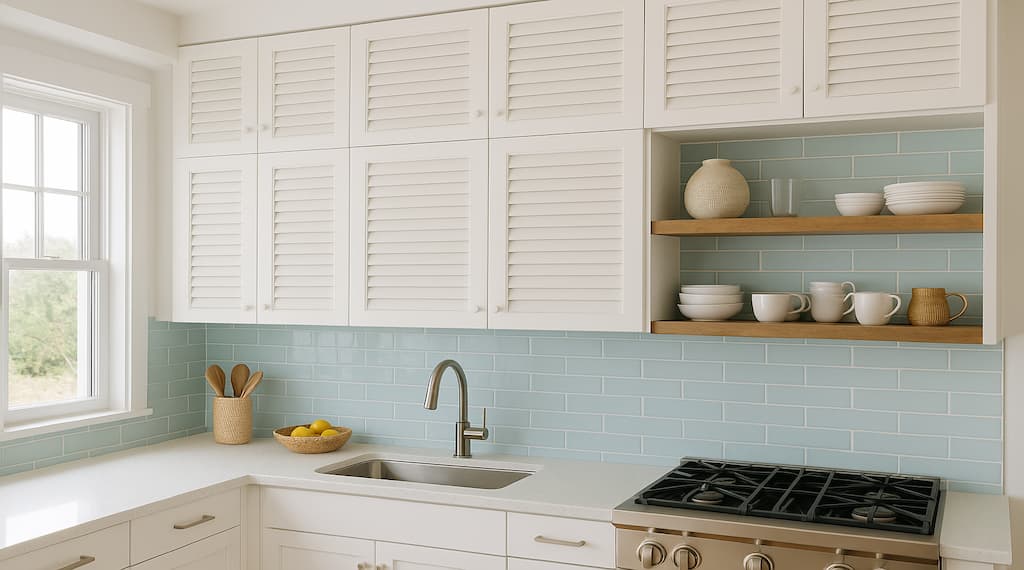
Tropical and Island-Inspired Spaces: Tropical kitchens often feature wood tones, rich textures, and designs that promote airflow. Louvered cabinets, especially in finishes such as teak or rattan-toned oak, blend seamlessly into these warm, organic spaces.
Example:
In an island home, a designer used teak-stained louvered cabinets below the kitchen windows to echo the screened porch outside. This allowed for better ventilation and tied the indoor space to the lush, humid environment around it. The result was a kitchen that felt connected to nature without losing polish.
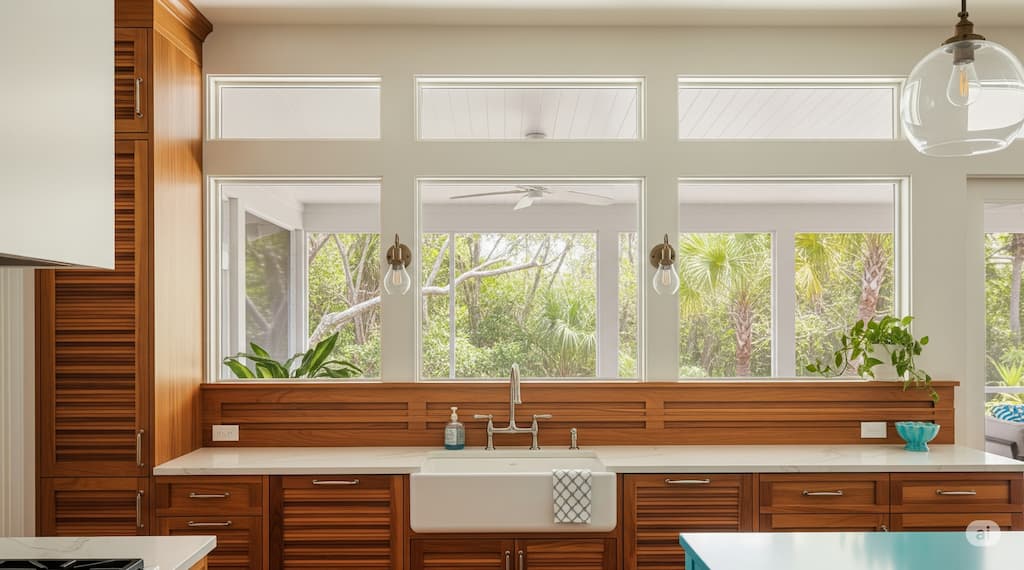
Traditional Kitchens
Though less common in modern traditional kitchens, louvered cabinets add an old-world charm when used selectively. Painted in cream or muted green, they can bring warmth and visual detail to pantries or utility nooks.
Example:
In a historic home, a narrow butler’s pantry featured inset louvered doors painted in a soft olive tone. The style respected the home’s original architecture while offering airflow for dry goods in the warm Southern climate. Crown molding and vintage hardware completed the timeless look.
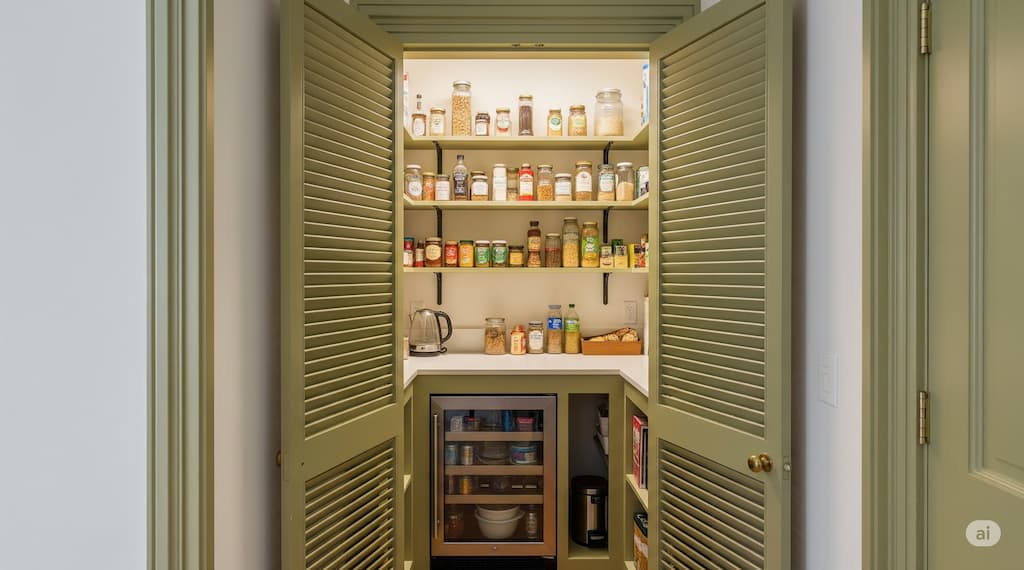
Cottage and Vintage Kitchens
Louvered cabinets are a perfect match for cottage and vintage-style kitchens, where texture and softness are key. When combined with open shelving, beadboard backsplashes, and pastel colors, they add just the right amount of charm.
Example:
A cottage kitchen renovation used robin’s egg blue louvered lower cabinets paired with butcher block counters. The slats added shadow and texture that balanced out the smooth farmhouse sink and vintage range. It felt playful, practical, and utterly faithful to the home’s 1940s roots.
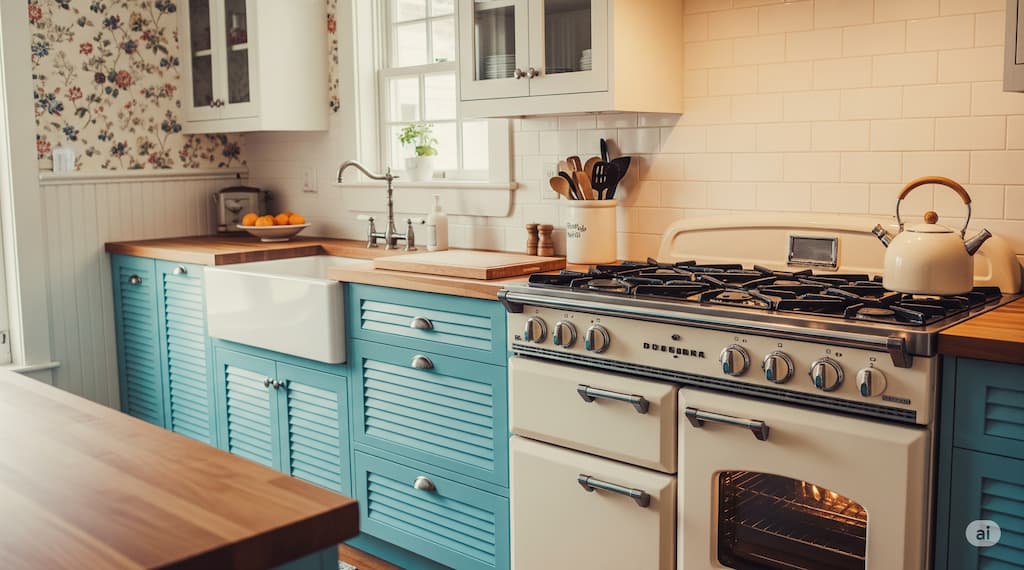
Each of these styles benefits from the same functional detail, airflow, and texture. Still, the way louvered cabinets are finished and placed helps them adapt to different moods and environments effortlessly.
Best Layout Ideas Using Louvered Cabinets
Louvered cabinets don’t just bring visual texture; they solve specific layout challenges, especially in areas where airflow, temperature control, or style variation is needed. Their design naturally supports function in spaces that benefit from ventilation or softness.
- Pantry doors or upper cabinets with louvers for airflow: Ideal for reducing moisture and improving circulation in dry food storage. White louvered uppers near windows can brighten the space while staying functional.
- Island cabinets with louvered accents: Island cabinets with louvered accents add contrast and break up large surfaces. Louvers used on island bases offer a stylish detail even when ventilation isn’t required.
- Appliance garages or wine storage with ventilation: Slatted doors help control temperature and airflow around small appliances or wine, keeping items stored safely and discreetly.
- Tall utility cabinets or built-ins in laundry zones: Great for storing linens, cleaning supplies, or gear in spaces where air circulation prevents musty buildup. They also maintain a seamless design flow between the kitchen and adjoining zones.
Louvered cabinets are most effective when placed where airflow or soft visual detail is required. Even used sparingly, they elevate the layout with a purposeful, polished look.
Cost Guide: Pricing for Louvered Cabinets
Louvered cabinets offer a unique style and function, but their prices can vary widely depending on the material, construction method, and level of customization. The design involves more detailed workmanship than flat or shaker cabinets, so it’s essential to know where to expect higher costs and where you can save.
Price by Material and Type (Custom vs Stock)
- Stock MDF louvered doors typically range from $100 to $250 per linear foot installed, making them an accessible option for budget-conscious remodels. These are often routed to mimic slats rather than using real ones.
- Semi-custom options, made from plywood or basic hardwoods, can range from $250 to $500 per linear foot, depending on the finish and slat detail.
- Fully custom hardwood louvered cabinets range from $600 to $1,200 per linear foot, primarily when real slats are used and finishes are hand-applied.
Material choice affects both the look and the final cost. Solid wood adds warmth and durability, but it also raises the price. In contrast, MDF or engineered wood keeps things affordable and ready for painting.
Labor Costs for Custom Slat Work or Faux Louvers
Creating actual louvered slats takes more time and skill than producing flat cabinet fronts.
- Functional, open slats require precise angles, spacing, and finishing, which increases labor costs.
- Decorative or faux louvers, routed into solid panels, reduce both material and installation time.
- Expect to pay 20–40% more in labor for real slatted doors compared to standard cabinet doors.
This makes faux louvers a smart alternative in areas where airflow isn’t essential but the design is.
Stock MDF vs Custom Hardwood Breakdown
Type | Material | Estimated Installed Cost per Linear Foot |
Stock MDF (painted) | MDF | $100–$250 |
Semi-Custom Plywood | Plywood | $250–$400 |
Custom Faux Louvers | MDF/Plywood | $300–$500 |
Custom Real Wood Louvers | Hardwood | $600–$1,200+ |
This range reflects national averages and can shift with region, supplier, and finish.
Budget Tips: Where to Use Louvers Strategically
- Focus on functional zones, such as pantries, islands, or laundry cabinets, where ventilation is crucial.
- Use louvers only on visible cabinet fronts, and keep the sides and interiors standard to save.
- Combine louvered accents with flat or shaker styles in the same kitchen for contrast without full investment.
- Opt for routed faux louvers if you want the look without the ventilation needs or added cost.
With the proper planning, louvered cabinets can fit most budgets, especially when used selectively or blended with other door styles.
Maintenance Tips for Louvered Cabinets
Louvered cabinets add airflow and texture to your kitchen, but they require slightly more upkeep than flat styles. Their slatted design can collect dust and grease, particularly in high-traffic areas like the stove or sink. With the proper care, they stay functional and stylish for years.
- Cleaning Between Slats with a Brush or Vacuum Tool: Use a soft-bristle brush, microfiber cloth, or narrow vacuum nozzle to remove dust. A weekly pass helps prevent buildup that’s tougher to clean later.
- Choosing Durable Paint for High-Use Zones: Satin or semi-gloss finishes resist grease and wipe clean easily. Avoid using flat paint near cooking areas, as it stains more quickly and wears down over time.
- Preventing Moisture Buildup in Slatted Designs: Cabinets near sinks or dishwashers should be adequately sealed. Moisture-resistant finishes or sealed wood protect against swelling and warping.
- Checking for Dust Collection and Hardware Wear: Inspect hinges and corners where slats meet the frame. These areas may collect grime or loosen with use and need occasional maintenance.
4 Mistakes to Avoid with Louvered Cabinets
Louvered cabinets offer both airflow and style, but misusing them or skipping small details can create problems down the line. Here are common mistakes to avoid when adding louvered doors to your kitchen.
- Using Louvers in Places That Don’t Require Airflow: Louvered cabinets are best suited for areas where ventilation is important, such as pantries, laundry zones, or storage spaces for electronics or cleaning supplies. Using them across the entire kitchen without a purpose can feel overdone and reduce design clarity.
- Choosing High-Gloss Paint That Highlights Dust: Glossy paint reflects light, revealing every bit of dust or smudge that settles on the surface. This finish can make maintenance feel constant. Stick to satin or matte-sheen finishes, which hide dust more effectively and offer a more relaxed appearance.
- Skipping Regular Cleaning, Slats Collect More Debris: The slatted design naturally traps more dust than flat doors. Skipping weekly cleaning means the buildup becomes visible and harder to remove later. This is especially noticeable on darker-painted cabinets, where lint and crumbs show more quickly.
- Poor Alignment or Spacing in Custom Designs: In custom cabinetry, incorrect slat spacing or uneven alignment significantly detract from the overall look. Louvers should be evenly spaced and properly framed. Ensure your cabinet maker uses precision tools and employs experienced craftsmanship to minimize visible flaws.
By avoiding these common missteps, you’ll keep your louvered cabinets functioning well and looking polished for years to come. Proper planning, the right finishes, and consistent care go a long way.
Louvered vs Shaker Cabinets: What’s the Difference?
Louvered and shaker cabinets are two distinct styles that offer very different aesthetics and purposes. Both have stood the test of time, but choosing between them depends on your kitchen’s layout, style, and functional needs.
- Design and Construction Differences: Louvered cabinets feature horizontal wooden slats with slight spacing between them. These slats may be fixed, operable, or decorative. They create a textured, ventilated surface that stands out visually and supports airflow.
Shaker cabinets are constructed with a flat, recessed center panel surrounded by a clean, rectangular frame. The design is balanced and straightforward, offering a smooth surface that’s easy to clean and visually calm.
While louvers require more detailed craftsmanship, shaker doors use clean lines and uniform proportions to stay understated and timeless.
- Function: Airflow vs. Simplicity: Louvered cabinets are chosen for both their aesthetic appeal and their functional benefits. The slatted design allows passive airflow, making them ideal for pantries, laundry cabinets, or spaces storing electronics or food. They also prevent moisture buildup in humid areas.
Shaker cabinets serve a more universal function. They offer a clean surface with minimal detail, making them easy to maintain and suited for nearly any storage application.
If you need ventilation or want to reduce stuffiness in closed spaces, louvered cabinets have a clear edge. For broad use and simplicity, shaker cabinets win on practicality. - Style Fit: Tropical vs. Transitional: Louvered cabinets lean toward tropical, coastal, or vintage design themes. They evoke warmth, movement, and a breezy feel that complements beach houses, bungalows, or island-inspired spaces.
Shaker cabinets are more transitional and flexible, fitting into both traditional and modern kitchens. Their neutral design makes them a go-to choice for homeowners seeking timeless appeal without a strong stylistic commitment.
Which Kitchen Layout Suits You Better?
Choose louvered cabinets if:
- You have a warm or humid environment and need airflow.
- Your kitchen has a coastal, tropical, or vintage theme.
- You want to highlight texture and detail on specific cabinets, such as a pantry, island, or tall built-ins.
Choose shaker cabinets if:
- You want a simple, clean, and widely accepted cabinet style.
- Your kitchen is transitional, modern, or classic.
- You need low-maintenance surfaces for a busy household.
Both styles have merit, but their differences are apparent in both form and function. Your kitchen’s layout, environment, and aesthetic goals will determine which one delivers the best fit.
FAQs About Louvered Kitchen Cabinets
What are louvered kitchen cabinets?
Louvered kitchen cabinets feature cabinet doors with horizontal slats or slatted designs, allowing air to flow through the cabinet interior. The slats can be open or decorative and are often seen in beach-style, tropical, and traditional kitchens. These cabinets bring texture, ventilation, and a relaxed design element to a space.
What’s the best wood for louvered cabinets?
Teak, oak, maple, and walnut are all solid choices for louvered cabinets, depending on your budget and style. Teak is ideal for tropical or humid environments due to its resistance to moisture. Oak offers strong grain and durability. Maple has a smooth, fine grain that lends itself well to painted finishes, while walnut adds richness and warmth to stained applications.
Are louvered cabinets suitable for kitchens with high humidity?
Yes, they are instrumental in humid environments, such as kitchens. The slatted design allows air circulation, helping to prevent moisture buildup inside cabinets. This makes louvered doors a smart option for storing dry goods, cleaning supplies, or items sensitive to humidity, particularly in coastal climates or homes with limited ventilation.
Do louvered cabinet doors collect more dust?
They can, particularly in the slat grooves. Compared to flat or shaker cabinets, louvered designs have more surfaces where dust can settle. Regular cleaning with a soft brush, vacuum nozzle, or microfiber cloth helps keep them tidy. Satin or semi-gloss finishes can also make cleaning easier by resisting grime and grease.
Can I paint or stain louvered cabinets?
Yes. Louvered cabinets can be painted for a fresh, bright look or stained to highlight natural wood tones. Painted finishes work well in coastal and cottage kitchens, while stains suit traditional or tropical styles. Ensure the paint or stain is moisture-resistant, especially in high-traffic areas like the pantry or sink zone.
Conclusion
Louvered kitchen cabinets bring together airflow, style, and craftsmanship. Their slatted design helps manage moisture while adding texture that flat cabinet doors can’t match. Whether you’re updating a coastal retreat, adding charm to a laundry nook, or seeking standout pantry doors, louvered cabinets provide a design solution that seamlessly blends function and personality. With the right material, finish, and placement, they enhance both the aesthetic appeal and functionality of your kitchen.

